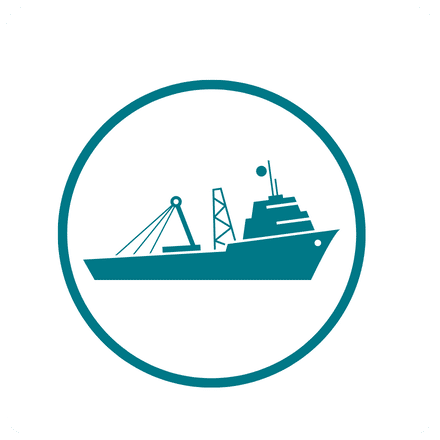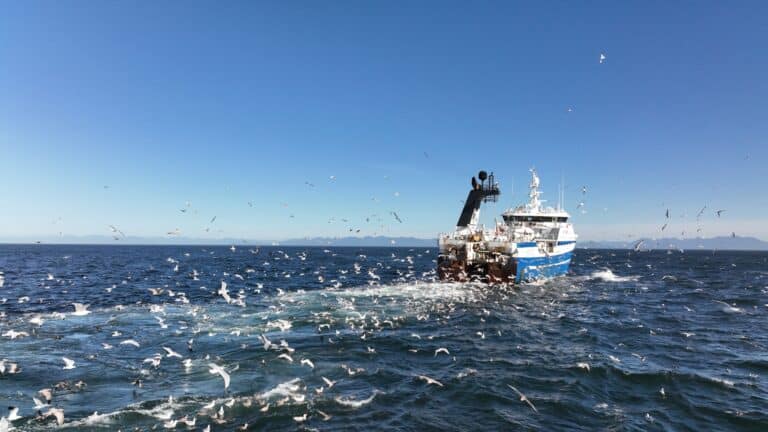End Industrial Trawling In B.C.
Trawling is known to be one of the most destructive and wasteful fishing techniques in the world. Dragging large nets through the water column or weighted nets along the seafloor, trawling wipes out vulnerable fish stocks, destroys habitats, and disrupts food chains.
our goal
Pacific Wild is calling for a moratorium on industrial trawl fishing to safeguard the health of B.C.’s ocean. Trawling is indiscriminate and destructive in nature and poses a significant threat to marine life and habitats.
What is trawling?
Trawling is a non-selective fishing technique in which large nets are towed behind fishing vessels, capturing everything in their path. Trawl vessels often carry gear for both mid-water and bottom trawling activities, and can switch between the two kinds of trawling activities depending on their active licence. When bottom trawling, vessels drag a large, weighted net along the seafloor, carving deep manmade highways through sensitive ecosystems and destroying already endangered coral and sponge reefs. This also stirs up sediment, releasing huge amounts of carbon. In their wake, bottom trawl nets leave gaping ecological scars that may take decades to heal and it has been likened to “marine deforestation.”
Research suggests that trawling generates the most waste of any fishing method because the unwanted catch is often dumped back into the ocean. Midwater trawling is a fishing technique that involves dragging a large net through the mid-depths of the water column to catch schools of fish like Pacific hake (also called haddock, Pacific whiting or Pacific cod). Like bottom trawling, midwater trawling is non-selective and incidentally captures over a hundred species as bycatch (unintentionally captured undersized, or non-target species). In Alaska even marine mammals as large as fin and humpback whales have been accidentally caught and killed by trawl nets. Ten killer whales, both Bigg’s (transient) and resident, were infamously captured by trawl nets in 2023 in the Bering Sea and Aleutian Islands.
Many Canadians would be appalled to know that, globally, at least 437 million tonnes of fish ($560 billion in revenue) were wasted due to destructive fishing operations between 1950 and 2014. Canada is a significant contributor to this global problem as industrial mid-water and bottom trawl vessels bulldoze through our oceans.
Industrial trawling
Industrial trawling, here defined as fishing with large-scale factory freezer vessels, has negative consequences including overfishing, bycatch, habitat destruction, and the depletion of juvenile and non-target species. Industrial trawlers are enormous killing machines operating largely offshore, out of sight, and out of mind. Industrial trawl vessels freeze their catch and thus are able to spend weeks at sea, fishing until their massive holds are full of target-species while dumping undersize and non-target species back into the ocean dead or dying. Below are six reasons to support the implementation of a moratorium on industrial trawling.
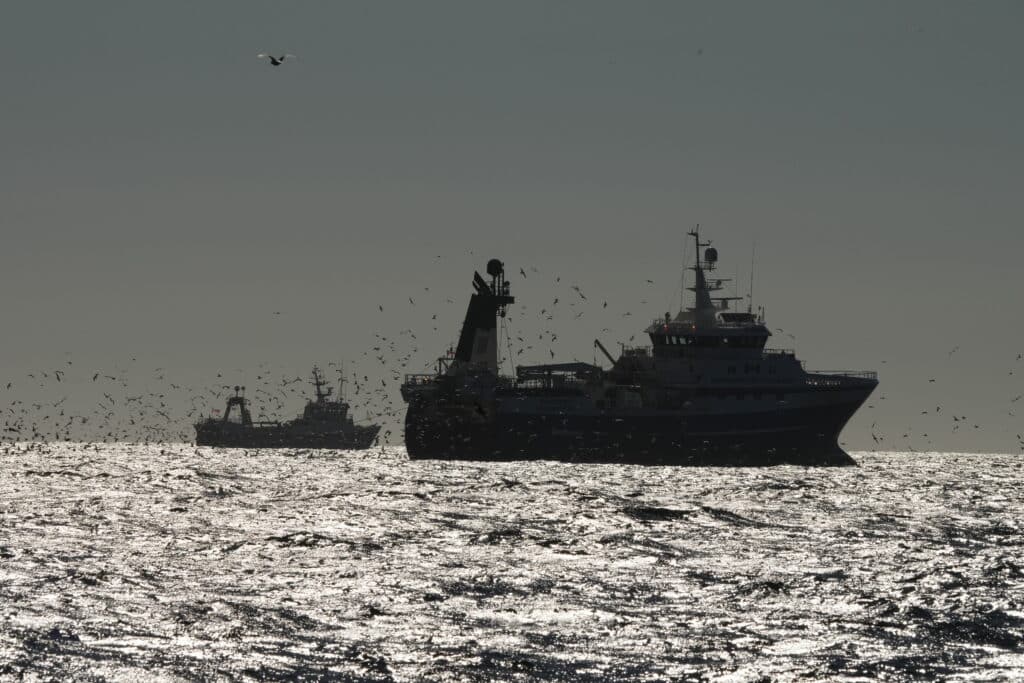
Six Reasons to Support a Moratorium on Industrial Trawling
1. Overfishing:
Trawling has been associated with overfishing, leading to the depletion of ecologically, culturally and economically important fish stocks. The non-selective nature of trawling operations contributes to biodiversity loss by impacting not only target species, but also non-target species. On average, trawlers discard 23% of their catch as bycatch, which often includes undersized individuals (juveniles) of the target fish species they are trying to catch. Like non-target species, juveniles are often discarded overboard, dead or dying as waste therefore eliminating future generations of fish. As different species are interconnected in ecosystems, the removal of certain species — like predators — can have cascading effects, affecting the entire marine food web. An infamous example of overfishing to collapse by the trawl fishery is Canadian Atlantic cod.
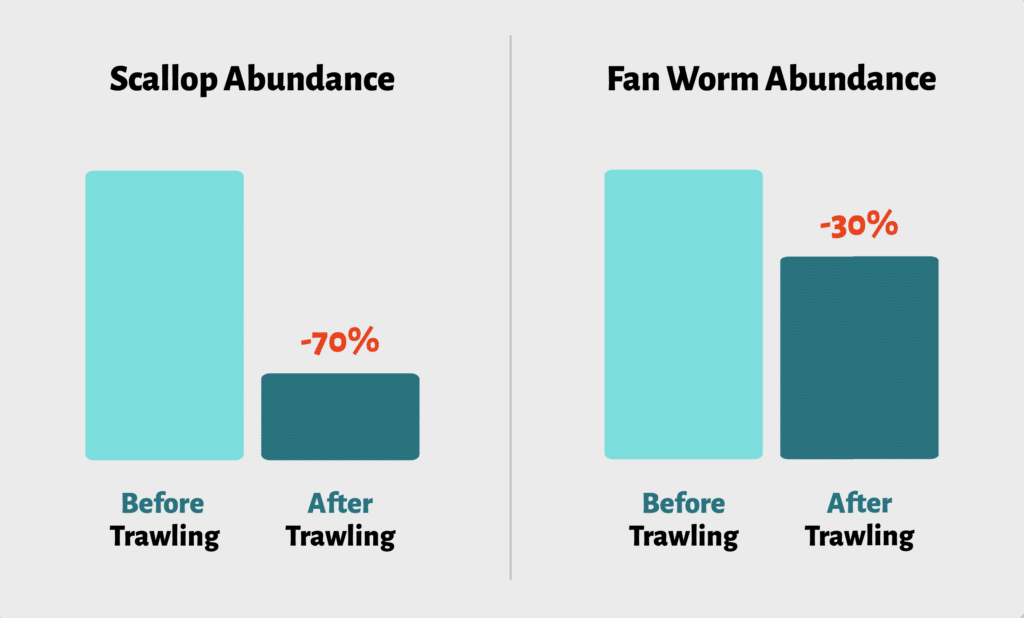
2. Bycatch and Discards:
Trawling involves dragging large nets, some spanning the size of a football field, through the water column or along the seafloor. These nets capture nearly everything in their path including both target and non-target species. This lack of selectivity contributes to bycatch, defined as the unintentional capture of undersized or non-target species. Bycatch often includes juvenile fish, non-commercial species, and even endangered or protected species. This can lead to ecological imbalances, the depletion of culturally important species and the wasteful discarding of non-commercial species.
On average, 23% of the reported fish and other marine species caught in trawl nets is thrown away as bycatch. The cumulative effects of trawling are summed up by Collie et al.’s literature review that estimates that a single tow causes an average 55% reduction in abundance of animals in the trawled area. When specific species are considered, trawling is estimated to lead to upwards of 68% reduction in abundance of invertebrate species. Bycatch records and monitoring programs indicate that the groundfish trawl fleet in B.C. caught over 28,000 Pacific salmon – 93% of which was Chinook (the primary food source for endangered Southern Resident killer whales) in the 2022/2023 fishing season alone.
Ecologically and culturally important forage fish like Pacific herring and eulachon are caught as bycatch as well as shark species including endangered basking sharks. In Alaska, at least ten killer whales were caught incidentally as bycatch by Alaska trawling vessels in 2023. Research has indicated that we are entering a sixth mass extinction. Banning non-selective resource extraction at an industrial scale is an actionable step we can take to preserve biodiversity and species at risk.
The issue of bycatch is just one example of how incongruent this fishery is with the sustainability of coastal communities and ocean prosperity. Coastal communities, in particular First Nations, have been fighting for the protection of herring, eulachon, rockfish, salmon and halibut for years. Many of these efforts have made great strides to protect these economically and culturally significant species inshore, while at the same time these same species are caught offshore by trawlers in the countless tonnes and thrown overboard, wasted as bycatch.
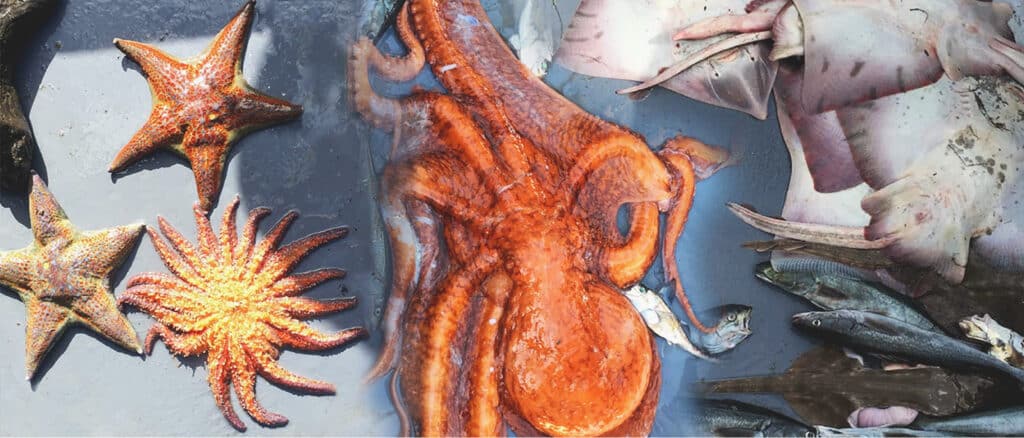
3. Habitat Conservation:
Trawling operations, specifically bottom trawling, cause extensive damage to marine habitats, including coral reefs, sponges, seamounts and other deep-sea benthic ecosystems. While some shallow-water ecosystems appear to recover from bottom trawling damage in under a decade, deep-water ecosystems, such as seamounts, and their long-lived or fragile species may be irreparably damaged. Some glass sponge reefs on B.C.’s coast have been aged at 9,000 years old. Unfortunately, scientists estimate that by the time the reefs were discovered in 1987, fishing activities like bottom trawling had already destroyed half of them. Some reefs bear the black scars of the “tracks” left behind by bottom trawl gear right over the glass sponge reefs.
4. Climate Change & Ocean Acidification:
Trawling releases as much, or more carbon than the entire aviation industry. The ocean is one of the earth’s largest carbon sinks, storing between 700 and 1000 gigatons of organic carbon with over 37,000 gigatons in intermediate and deep sea regions. For comparison, the atmosphere only holds an estimated 780 gigatons of carbon dioxide (CO2). By disturbing marine sediments, bottom trawling exacerbates the climate crisis by emitting a significant amount of CO2, releasing an estimated 0.58 to 1.47 gigatons each year purely through the disruption of ocean sediments. Additional research indicates that over half the CO2 in the water released from the seabed by trawlers will make it to the atmosphere within nine years while the rest may contribute to ocean acidification.
Despite the climate consequences of trawling, there is little to no publicly available information on the effects of trawling on the climate in Canada, nor is it clear whether the government intends to research the industry’s total carbon footprint. Turning a blind eye to the climate consequences of trawling does not fulfil the letter or the spirit and intent of international agreements signed by Canada to be a climate leader.
5. Economic and Social Health:
Industrial trawling causes economic injustice and can negatively impact the long-term sustainability of fisheries and the food security of coastal communities. By catching a wide range of species, including those that are not economically valuable, trawling can contribute to the overexploitation of marine resources and compromise the health of fish stocks. Small-scale fisheries and coastal communities are disproportionately affected by large-scale trawling operations. B.C.’s fisheries are in an economic state that prevents fishers and communities from seeing significant economic benefits from industrial fishing. The trawl fishery remains consolidated in the hands of a few wealthy individuals or corporations (including foreign ownership), the number of jobs in the fishery is shrinking as industrial trawlers displace smaller fishing vessels, and the economic prospects of fishers have gotten worse. A fleet composed of smaller-scale vessels has the ability to employ considerably more people while using less obtrusive fishing techniques.
Fishers in B.C. have seen an average 29% decrease in their incomes between 2000 and 2015*
*This figure accounts for changes in the value of the Canadian dollar
6. Inadequate Monitoring & Enforcement:
To date, DFO boasts decades-long failure to implement measures to restore the abundance of severely depleted stocks. In a recent performance audit, the Office of the Auditor General of Canada (OAG) uncovered that Fisheries and Oceans Canada (DFO) is doing a shockingly ineffective job at monitoring Canada’s commercial fishing industry. In the absence of proper monitoring, the audit points out that DFO can not ensure that the fishing industry is sustainable and as a result, our fish stocks may already be overexploited. In 2023, there are no healthy forage fish populations in either Atlantic or Pacific regions and many populations of Pacific salmon are famously failing to thrive.
Until 2020 at-sea observers were placed onboard trawl vessels and tasked with monitoring the species, bycatch, collecting data for DFO and holding trawl fishers accountable for the behaviour out at sea. The observer program has been heavily scrutinized for its’ efficacy and ethics, with whistle blowers detailing accounts of sexual harassment, intimidation, harassment, and bribes, pressuring observers to grossly under-report their findings or look the other way when infractions occur. When COVID-19 swept the globe, the onboard observer program was put on hold, yet trawling never ceased operation. Human eyes were hastily replaced with electronic monitoring systems and other industry preferred methods.
Despite the alarming red flags surrounding the onboard observer program, nothing can replace firsthand observations from human eyes. Over the 2022/23 fishing season, enforcement patrols record numerous violations by trawlers further inhibiting proper monitoring including fishing without working cameras, fishing with dirty cameras, fishing with an inadequate number of cameras and not submitting fish slips. As trawling occurs offshore, far from the eye of fisheries managers, the actual number and magnitude of violations is likely higher than what was observed and reported.
a major issue for canadians
55% of Canadians believe trawling is not allowed in Canadian waters, yet it is.

Trawling for Truth
Because trawling takes place in a largely out-of-sight out-of-mind way, Pacific Wild sought to understand how much the Canadian and British Columbia public knew about this industrial fishing practice. In June 2022, we commissioned an independent polling company, Research Co., to structure a series of questions that would gather preliminary data on public opinion regarding the bottom trawl fishery in B.C. This technical blog explores the results.
MoviNG Forward
While we believe that an eventual ban of bottom trawling is necessary, we also understand that it is not that simple. Bottom trawling involves millions of dollars, generations of families, government subsidies and endless bureaucracy.
The paper ‘Dragnetting Coastal Communities‘ looks at the economic and political inequality in the B.C. trawling industry, and the problematic absence of transparency shielding the true ecological harm created by this fishing technique from public scrutiny and accountability. A significant increase in transparency is a fundamental component needed for policy changes.
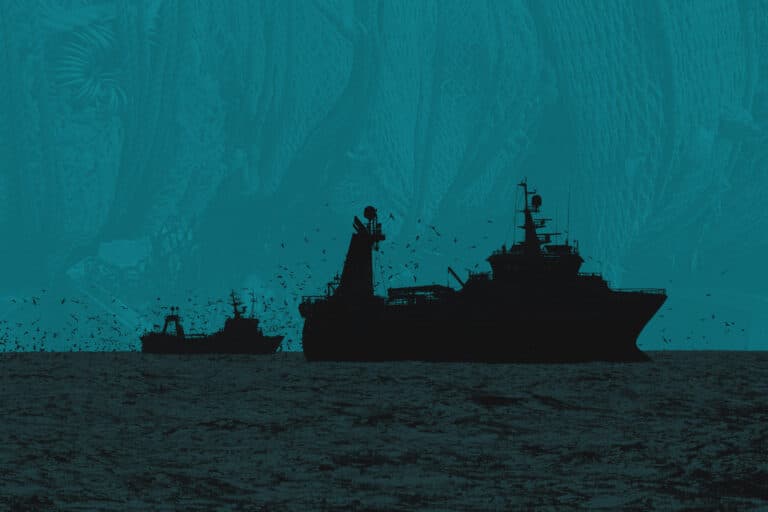
Read Now: “Dragnetting Coastal Communities”
Pacific Wild’s new research paper looking at the need for transparency and economic reform in B.C.’s trawler fishery.
Working towards evidence-based solutions and fisheries management that supports ecosystem-based management is the key to supporting communities and government through enacting these changes. Canada should look to other nations who have proactively taken steps to ban trawling, or at the very least, bottom trawling from their oceans.
The B.C. trawl fishery is operating along the very same waters, managed by the very same governmental structures that managed whales into oblivion, basking sharks to near extinction, and sea otters to extirpation. Yet somehow the end result is expected to be different. Right now factory trawlers are dragging the bottom of the continental shelf bulldozing the ocean floor, akin to bulldozing the rainforest for a few commercial species.
We urge the newly elected government to implement effective environmental protection strategies and fisheries management practices that are environmentally and socially beneficial. Stay tuned for more ways you can get involved and push for more sustainable fisheries.
